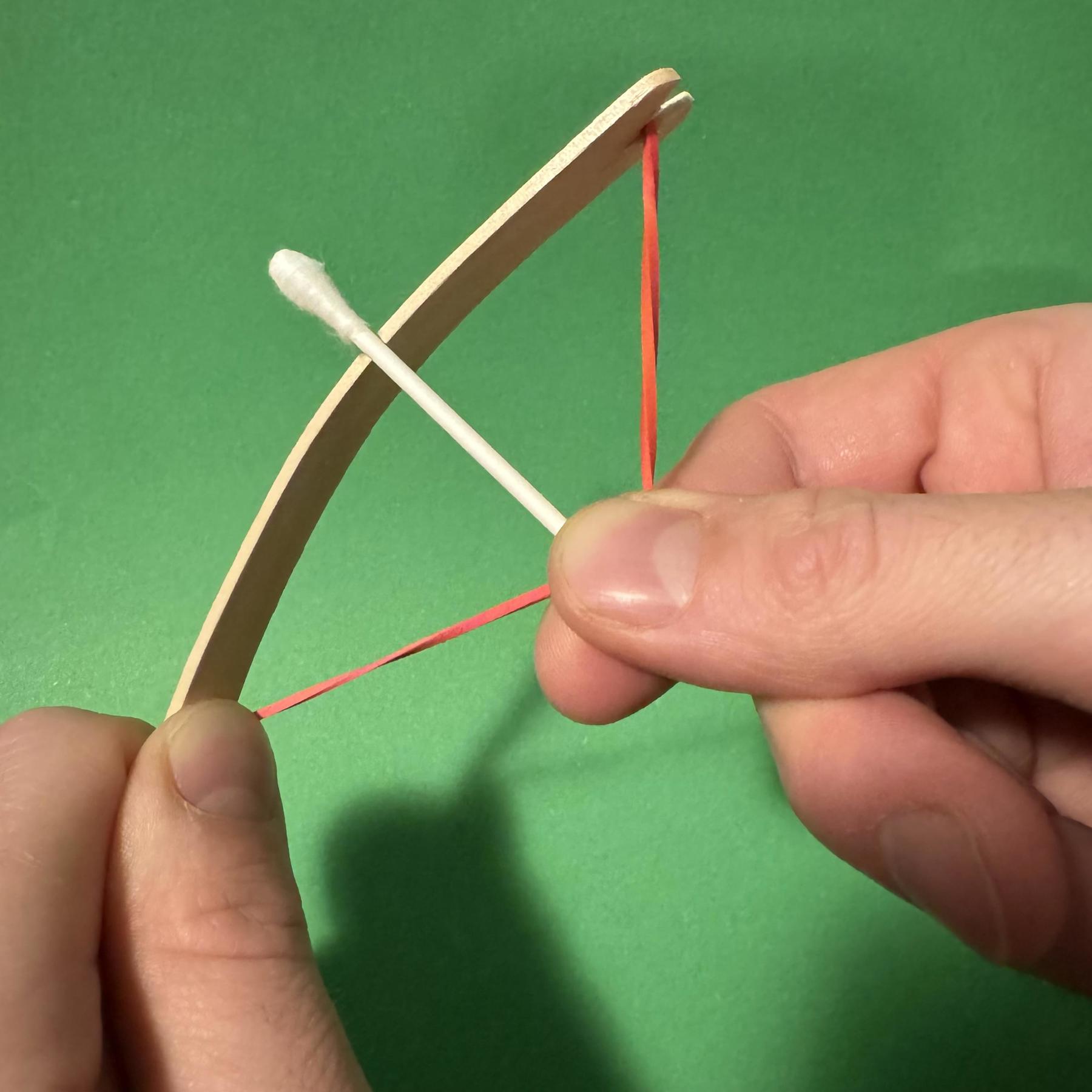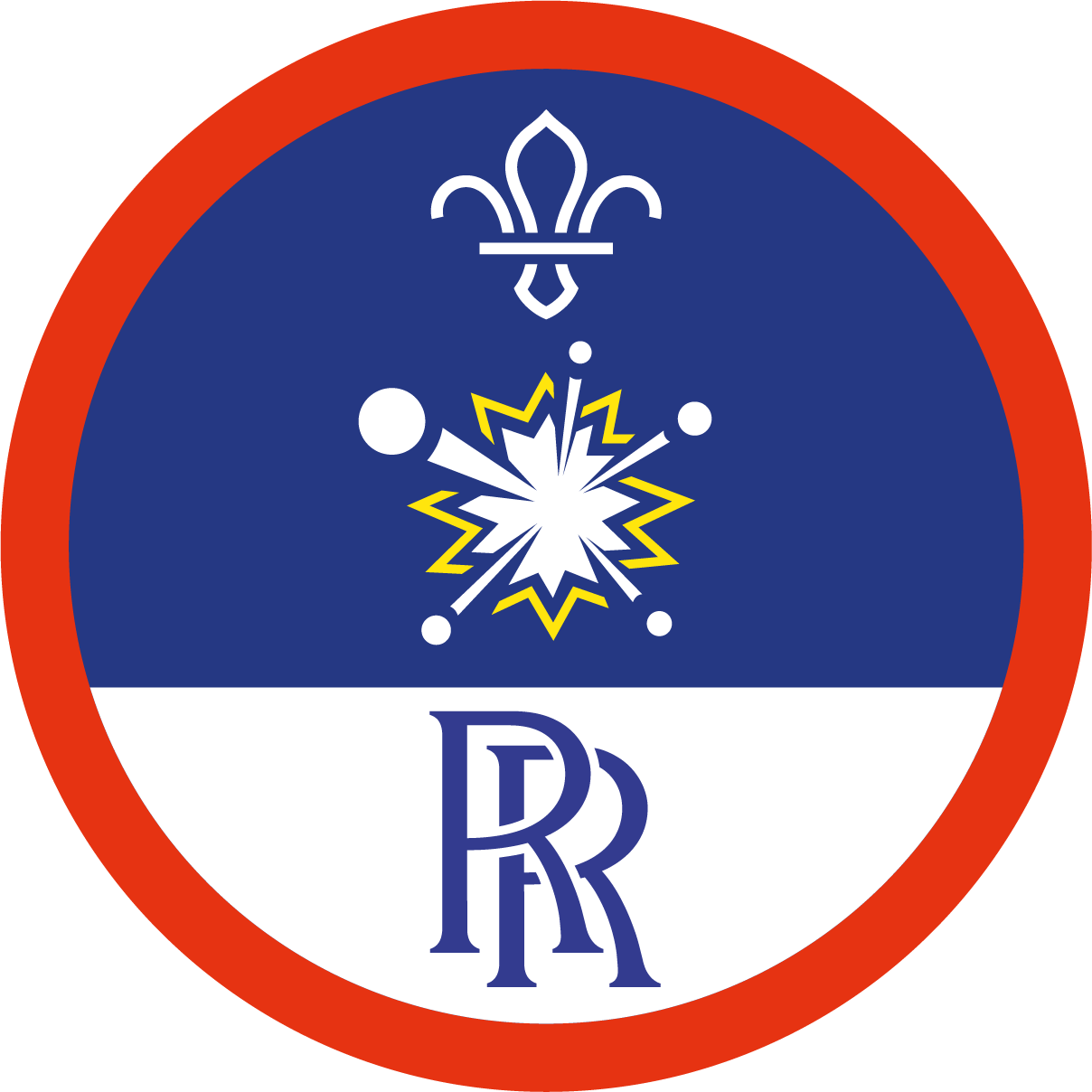
Make a mini bow and arrow
You’ll need
- Lolly sticks (soaked in water for 1 hour)
- Cotton buds
- Dental floss
- Targets, such as cones, markers or hoops
- Curved or spherical object, such as a tennis ball, mug or bowl
- Scissors
- Desk fan (optional)
- Colouring pens/pencils (optional)
Before you begin
- Use the safety checklist to help you plan and risk assess your activity. There's also more guidance to help you carry out your risk assessment, including examples.
- Make sure all young people and adults involved in the activity know how to take part safely.
- Make sure you’ll have enough adult helpers. You may need some parents and carers to help.
Planning and setting up this activity
- It’s best to soak the lolly sticks in water for at least one hour before the session, so that they become soft and flexible.
- You’ll need at least one lolly stick per person, and you may want some spares in case any snap.
- You can find information about the science behind how a bow and arrow works on this page. Encourage people to question why something works or doesn’t work, or why they think something will work, is a way to explore this in an active and engaging way.
Running this activity
- Gather everyone together and ask if anyone’s used a bow and arrow before. Explain that you’re making a mini version using a lolly stick.
- You can use a lollipop stick with either an elastic band or dental floss, or you could try using something else. Why not experiment with different materials and see which one works best?
- Soak the wooden lollipop stick in water for 10-15 minutes to make it more flexible.
- Carefully and gently bend the lollipop stick to create a slight bow shape.
- Use a pencil to mark about 0.5 cm from both ends of the stick.
- Carefully use scissors to make small notches at the marked spots on both ends of the stick. These notches will hold the elastic band.
- If you want to, you can decorate the lollipop stick.
- Take an elastic band and stretch it between the two notches on either end of the lollipop stick. Make sure it’s tightly secured in the notches.
- To make your arrows, carefully cut off one end of a cotton bud using scissors. You could use scissors to make a small notch in the cut end of the cotton bud. This’ll help it stay against the elastic band when you use the bow.
- Place the cotton bud on the bow and arrow, holding it horizontally against the elastic band.
- Test the bow and arrow. Pull the cotton bud back while holding the bow steady, aim, and release it to fire!
- If more tension is needed, you can try a smaller or thicker elastic band, or deepen the notches.
- Soak the wooden lollipop stick in water for 10-15 minutes to make it more flexible.
- Carefully and gently bend the lollipop stick to create a slight bow shape.
- Use a pencil to mark about 1.3 cm from both ends of the stick.
- Using scissors, carefully make small notches into both sides of the lolly stick where the mark is on both ends of the stick. These notches will hold the dental floss.
- If you want to, you can decorate the lollipop stick.
- Now, wrap and tie dental floss tightly around one end of the stick, tightly securing it in the notches. You may want to wrap it a few times.
- While keeping the stick bent, carefully wrap and tie the other end of the dental floss around the opposite end of the bow, making sure the floss is tight. This will help maintain the bow shape and create tension.
- To make your arrows, carefully cut off one end of a cotton bud using scissors. You could use scissors to make a small notch in the cut end of the cotton bud. This’ll help it stay against the elastic band when you use the bow.
- Place the cotton bud on the bow and arrow, holding it horizontally against the dental floss.
- Test the bow and arrow. Pull the cotton bud back while holding the bow steady, aim, and release it to fire!
- If more tension is needed, you can try a smaller or thicker material, such as thicker floss or elastic thread, or deepen the notches.
There are lots of forces that act on the bow and arrow that affect the way the arrow flies. These include energy transfers, gravity and air resistance.
Energy transfers
- The bow bends when the archer pulls back on the bowstring. The bow can bend because it is made of an elastic material.
- This transfers energy to the bow. The energy stored in the bow is called elastic potential energy.
- When the bowstring is released, the stored energy is transferred to the arrow. The shape of the bow helps make this energy go straight to the arrow.
- In technical terms, the elastic potential energy of the bow is converted to the kinetic energy of the arrow. Kinetic energy is the name for energy stored in a moving object.
Gravity and air resistance
- As the arrow flies, it will be affected by the force of gravity, pulling it towards the ground, and air resistance, slowing it down.
- Gravity means that the arrow will end up falling to the ground, rather than flying forever.
- You have to compensate for the effect of gravity, when you’re choosing what angle to fire your arrow from. If you’re trying to make your arrow go the furthest distance, you have to find the perfect balance – firing it not too high, but not too low.
- Air resistance is a type of friction between air and another material, in this case, the arrow. Friction is a force that slows objects down and it happens when an object moves through water or air.
- Long and thin objects, like arrows, can move through the air more easily. They’ve got an aerodynamic shape. Objects with a larger surface area create more air resistance.
Try out your mini bow and arrow
- When everyone’s ready, set up some small targets, such as toilet tubes, hoops, paper plates or other markers. You could have different markers, with each one worth a different number of points. People could write down their scores or just play for fun.
- Let everyone take it in turns to carefully have a go with their mini bow and arrow. Remind everyone not to point the bow and arrow at humans or animals.
- People can experiment with their bow to see what helps. They could change their technique, the angle they fire it at, the height they launch it from, the bend in the bow, the amount of dental floss and so on.
- At the end, gather everyone back together and reflect on what went well. How well did the bow and arrows work? What helped and what didn’t? Did anything slow the arrow down or change its course? What did people change? Did that help? Why do people think that was? You could talk about the power of the bow; the effect of gravity pulling the arrow down to the ground; and the effect of air resistance slowing the arrow as it flies.

Reflection
This activity was a way to have fun and explore the science behind an activity you might do at Scouts.
Did you find anything difficult, or have any problems? How did you resolve them, or what would you do differently next time?
How is your mini bow and arrow different or the same as the real thing? What worked best for you? How did you get your arrow to fly further or higher? Did anything make it worse?
Safety
All activities must be safely managed. You must complete a thorough risk assessment and take appropriate steps to reduce risk. Use the safety checklist to help you plan and risk assess your activity. Always get approval for the activity, and have suitable supervision and an InTouch process.
- Scissors
Supervise young people appropriately when they’re using scissors. Store all sharp objects securely, out of the reach of young people.
- Sharp objects
Teach young people how to use sharp objects safely. Supervise them appropriately throughout. Store all sharp objects securely, out of the reach of young people.
- To make this activity easier, you could prepare the lolly sticks and cotton buds beforehand.
- To make this activity harder, you could experiment with using other materials to make your bow. For example, you could try using yarn, wool or an elastic band for your bowstring. You could also use a desk fan to alter the air resistance or to introduce side winds. How does this affect the flight of your arrow? For example, you may need to aim left to compensate for the wind, or aiming higher because the target is further away.
- This might be tricky for people who struggle with fine motor skills. People could work in pairs and support each other to make their mini bow and arrows.
- Larger materials could be used, such as larger craft sticks or twigs instead of lolly sticks, and yawn/wool instead of floss.
- The mini bow and arrows could be made before the session, so people just need to decorate them and have a go.
All Scout activities should be inclusive and accessible.
If you enjoyed this activity, you could try another science activity or try soft archery.
Young people can take the lead with making any adjustments to their mini bows and arrows. They can decide on targets to set up, and they could also create any extra challenges, such as hoops.

